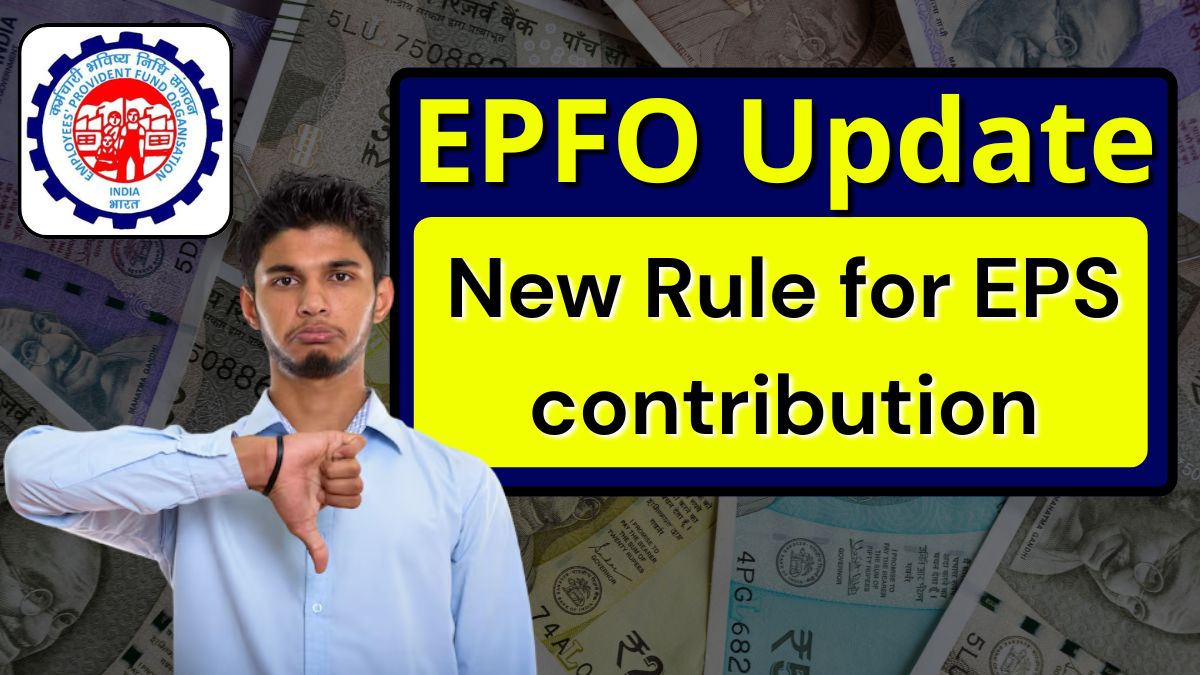EPFO new rule for EPS contribution: A Major Change in the EPFO System — What It Means for You
If you’re a salaried employee contributing to the Employees’ Provident Fund (EPF), there’s an important update you shouldn’t ignore. The Employees’ Provident Fund Organisation (EPFO) has introduced a new rule under its upgraded Electronic Challan-cum-Return (ECR) system — and it could directly affect your pension eligibility.
Starting September 2025, some employees will no longer be able to contribute to the Employees’ Pension Scheme (EPS). The move is part of EPFO’s effort to automatically detect incorrect contributions and maintain accuracy in pension records.
Now, the question everyone’s asking is — who will be affected by this new rule? Let’s break it down simply.
Who Can’t Contribute to EPS Under the New Rule?
Under the updated system, two categories of employees will be automatically flagged and excluded from EPS contributions:
- Employees aged 58 years or above
Once you reach 58, you’re no longer eligible to contribute to the pension scheme. The logic is simple — EPS is designed for long-term pension building, and contributions after this age don’t align with the scheme’s structure. - Employees earning more than ₹15,000 per month who joined EPS on or after September 1, 2014
According to EPFO rules, such employees are not eligible for EPS benefits. Until now, some employers were mistakenly contributing to their pension accounts. With the new ECR system, those contributions will be automatically blocked.
So, if you fall under either of these categories, your EPS contribution will stop automatically — saving you and your employer from correction hassles later.
What Exactly Is the ECR System and What’s Changing?
The Electronic Challan-cum-Return (ECR) is the digital system employers use to submit PF and pension contributions for their employees.
Earlier, even if employers made incorrect pension contributions — for instance, for employees over 58 or earning more than ₹15,000 — the system accepted them. Later, those entries had to be manually corrected, leading to confusion and disputes.
The new auto-validation feature changes that. Now, as soon as a wrong entry is made, the system will detect and reject it automatically.
This means:
- No wrong pension deductions from employee salaries
- No unnecessary corrections or refund delays
- More transparency in how pension contributions are recorded
It’s a small but powerful step toward streamlining one of India’s largest social security systems.
How Is Your EPF Pension Actually Calculated?
Many employees still believe their pension depends on how much money they contribute — but that’s not exactly true.
Here’s the reality:
- Every month, your employer contributes 12% of your basic salary and dearness allowance (DA) to your provident fund.
- Out of this, 8.33% goes to your Employees’ Pension Scheme (EPS), and the rest stays in your EPF account.
- However, the maximum amount that can be deposited into EPS is ₹1,250 per month (as per the rule since September 2014).
- Even if your salary is higher, your EPS contribution doesn’t increase — only your EPF (provident fund) balance grows.
In short, your pension amount isn’t about how much you save — it’s based on a fixed formula involving your pensionable salary and service period.
Example: How the Rule Impacts Employees
Let’s say Ramesh, a private company employee, earns ₹20,000 per month and joined his job after September 2014. His employer has been contributing to EPS every month.
Under the new ECR system, those contributions will no longer be accepted, because his salary exceeds ₹15,000 and he joined EPS after the cutoff date. His entire employer contribution (12%) will now go directly into his EPF account, increasing his PF savings — but he won’t be eligible for a pension under EPS.
On the other hand, someone like Suresh, who’s been part of EPS since 2012 and earns ₹14,000, will continue to contribute normally and remain eligible for pension benefits.
Why This Rule Matters
This update might sound technical, but it has real-world importance. By automatically detecting ineligible contributions, EPFO is:
- Ensuring fair use of pension funds
- Protecting eligible employees from system errors
- Making the entire process faster and more reliable
It’s another step toward a fully digital and transparent social security framework — something that directly benefits over 7 crore EPF members across India.
Frequently Asked Questions
1. What is the new EPFO rule for EPS contribution in 2025?
EPFO’s updated ECR system will automatically stop pension contributions for employees over 58 years or earning above ₹15,000 who joined EPS after September 1, 2014.
2. When will this new rule be implemented?
The rule will take effect from the salary month of September 2025 for all employers filing ECR online.
3. Will this affect my Provident Fund (EPF) balance?
No, your EPF balance will continue to grow. Only the EPS (pension) part will stop for ineligible employees. The full employer contribution will instead go to your EPF account.
